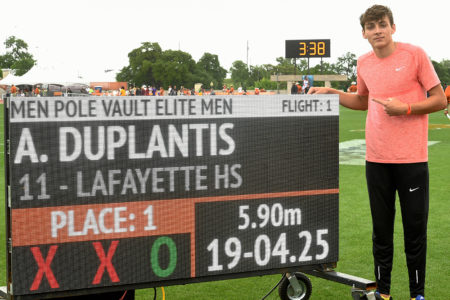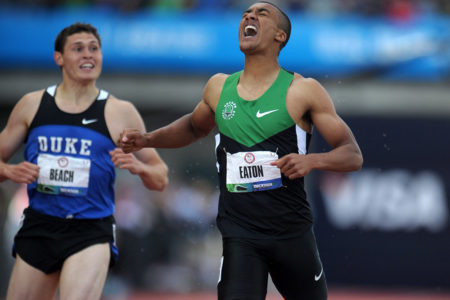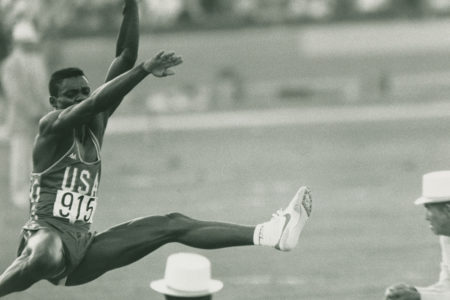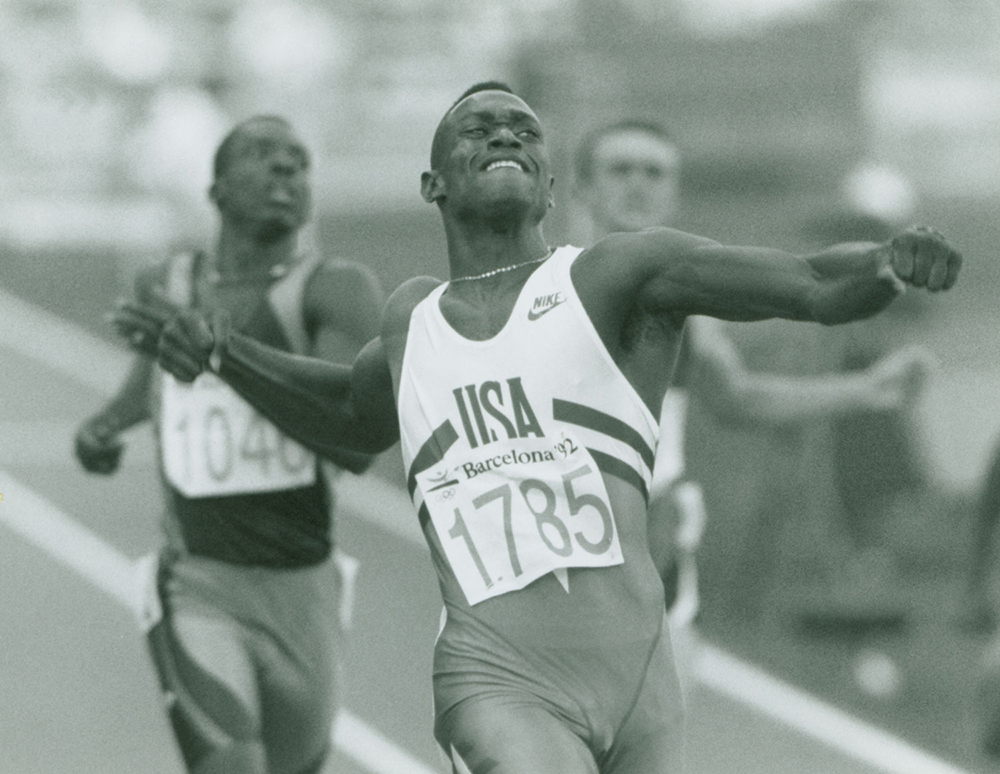
”Kevin, it looks like the vultures are circling.” Frank words 400 hurdles World Record holder Kevin Young heard from a friend last summer. Twenty-six full seasons have come and gone since Young raced to gold at the Barcelona Olympics with a time of 46.78, the longest-standing men’s WR in a standard running event.
But in light of the performances of Abderrahmane Samba and Rai Benjamin in June, Young had to agree with his buddy. “I said, ‘Yeah, they are,’ “ Young recalls. “Anybody who runs under 47 seconds, they’re trying to do something, and anybody who’s run 47.02, they’re trying to do something too.”
It’s obvious who “anybody” in this ultra-elite category encompasses. Samba, of course, is the Qatari who first took up the hurdles in ’17 and dropped a 46.98, history’s second sub-47, at the Paris DL last June. Three weeks prior, Benjamin, a USC junior at the time, raced 47.02 in the NCAA final to equal the then-No. 2 all-time mark by Edwin Moses, legendary author of the event-record 122-race, 9-plus-years unbeaten streak 1977–87.
Not vultures, Samba, 23, and Benjamin, 21, have annointed themselves the hunters with Young’s WR the target in the crosshairs.
How should they chase it? Young starts by observing both have the tools, not just hurdle PRs in the neighborhood. Start with their flat 400s: 44.62 for Samba, 44.74 for Benjamin, times run last year. Young’s best, set in April of his WR season, was 45.11. He also split 44.4 in a 4×4 at the ’88 NCAA, second leg for the UCLA team that burned the first collegiate sub-3:00 time.
OK, Benjamin split 44.63 on a CR team last year. Indoors. For USC’s baton Collegiate Record at the outdoor NCAA, he ran 43.6 less than an hour after his 47.02.
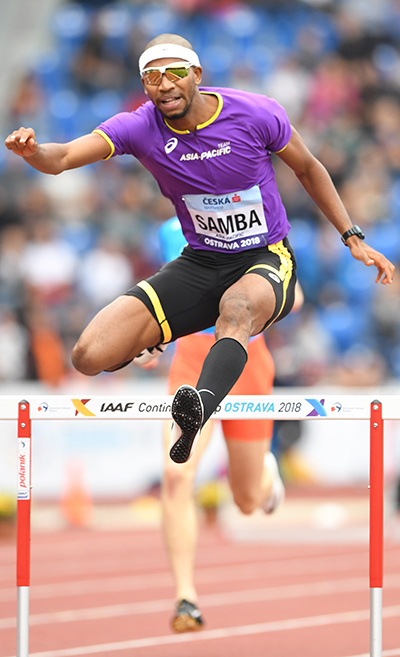
Samba’s fastest 200, a wind-aided 20.94 in ’15, is comparable to Young’s, a wind-legal 20.86 at mile-high altitude in ’86. Now first-year pro Benjamin “merely” became the first 400H man with a sub-20 deuce best, cranking 19.99 at the same DL meet where Samba raced his hurdles best.
Naturally, Young has watched video of last season’s 46.98 and 47.02 races. First Benjamin’s NCAA win. “I was in Kentucky with Sharrieffa Barksdale [the first collegiate woman sub-55 hurdler and now USATF’s Alumni Relations Manager] during a clinic that I do with her every year,” Young says. “Every time we’re always in the break room switching between the NBA Finals and the NCAA meet, probably like everybody else. So we’re going back and forth through the channels and of course everybody has their own personal schedule but when the 400 hurdles race was being run everybody was glued to their seats, like, ‘Wow, here we go.’ Then to see my man run as fast as he did, it’s crazy.”
Watching the TV, Young thought he might have seen Benjamin turn a 12-step hurdle along the way. He says, “I reached out to him on Instagram, I said, ‘Yo! What did you do in the race? You didn’t go 12 in there, did you?’ He said, ‘I went 13 all the way around.’ I said, ‘Wow! OK, cool, that’s interesting to find out.’ ”
Benjamin did, in fact, drop some 12-step hurdles into his races last season, surprising himself the first time it happened in his Pac-12 heat.
Samba made a sparkling impression on Young as well: “I think the X factor in his regard is that he can alternate his ass off, he’s a great runner period.” In Paris Samba ran 13 steps through 7 and then without a hitch changed up to 14s for barriers 8, 9 & 10.
The second half of the 400 hurdles—seamless adjustment if it’s called for over the barriers in the second turn and speed endurance to bring it home in the stretch—is the path to gold per Young’s analysis. “To be honest with you, he says, “I thought that maybe Angelo Taylor [Oly gold medalist in ’00 & ’08] would have broken the record by now.” Taylor was a world-class flat 400 man with a 44.05 best and 20.23 PR at 200 but the Georgia Tech alum topped out in the hurdles at 47.25.
Young isn’t singling out Taylor, who is, after all, one of just four men to win a pair of Olympic golds. Young says, “I’ve seen Kerron [Clement, twice a world champ], probably Bershawn [Jackson, world champ in ’05], I’ve seen [Karsten] Warholm, I’ve seen so many hurdlers run that first deuce way much faster than I’ve ever raced it in my life yet not had the back end to run it under 47 seconds. I’m not saying they didn’t have it, but they didn’t show it. And why they didn’t show it, and I’ve seen this over and over again, is because of that transition from the fifth hurdle to the eighth. A lot of guys are transitioning, they’re going from 13 steps to 14 or from 14 to 15. They’re adding steps as opposed to maintaining their tempo and no one’s taking out a step. We all know that the holy grail in hurdling is you gotta go at least 13 steps.” Since Moses—Edwin—that has been the rule. Generally.
Starting in ’86, Young who had walked on at UCLA the previous year, began using a 12-step pattern, alternating lead legs, for some hurdles in the first halves of his races. Twice in his career Young, standing 6-4 (1.93), hit just 11 strides between two of the 10 hurdles. The first time was at the ’86 NCAA. Jacked up over facing Iowa State Olympian Danny Harris, he says, “I was so anxious being next to the silver medalist from ’84. I blasted out of the blocks and got to the first hurdle with my right leg instead of my left leg. I took the first hurdle at 19 steps [20 was his norm], right leg lead.” He alternated (12 steps) through 4 but then facing the fact that a downshift to 13 thereafter would force him to hurdle 5–10 leading with his non-preferred right leg, Young in the moment took “a leap of faith” and lunged for the barrier off step 11. His trail leg knee clipped the hurdle yet he stayed upright. He remembers, “I finished the race, the fatigue hit me, beat me up, Danny caught me, passed me, won his third NCAA championship. I was the runner-up, I was just as happy, I PRed, 48.77.”
Six years later, between the third and fourth hurdles in his Barcelona Olympic heat Young took 11 steps for the second time. He backed off early in the homestretch (“Qualifying rounds are for qualifying”), eased home in 48.76 (“same numbers as in the record”) and remembers realizing as he walked off the track that the final promised enchanting possibilities. That heat, far more than his subsequent 47.63 semi, which he chastised himself for running harder than he needed to, told Young the WR was in play. “Uh-oh,” Young recalls telling himself. It’s going to be a crazy day out there. I just need to keep my cool and don’t get freaked out like I did in ’88.”
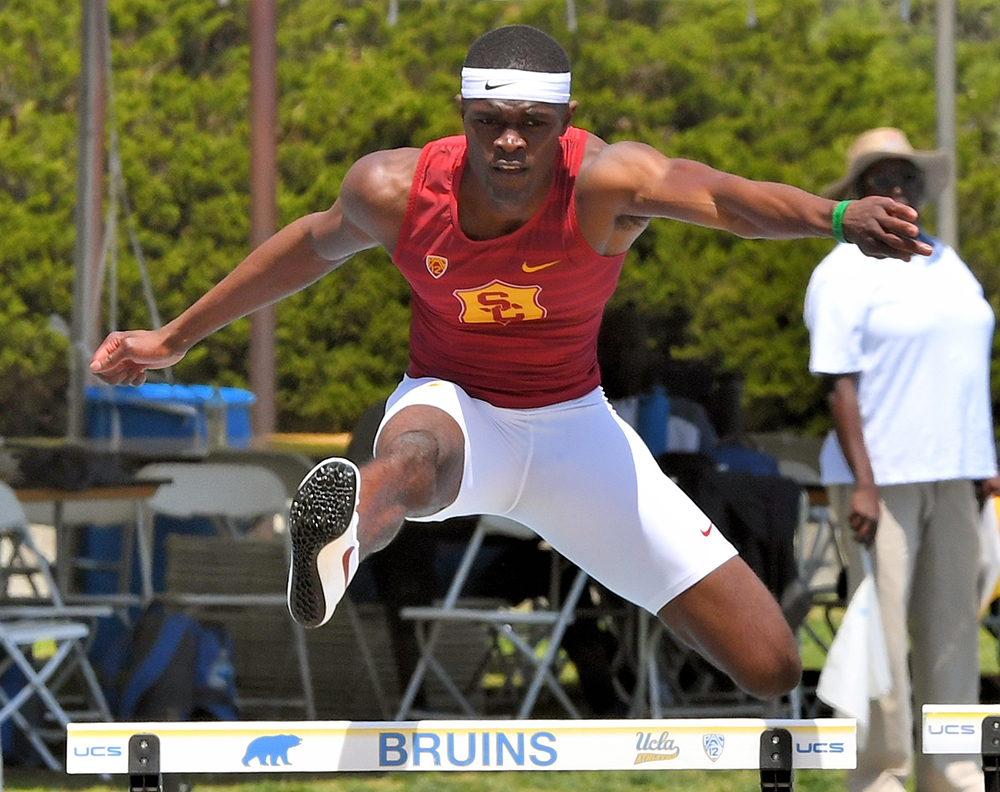
Be nimble, capable of adjusting on the fly if you have to, Young emphasizes for any advice Samba or Benjamin might want, but plan the race pattern that will bring out your fastest effort.
“I literally wrote it down and calculated what Kevin Young was capable of doing,” he says. He practiced it too and urges any athlete who hopes to break his record to do the same. “This is the way in which I would expect coaches to help their athletes understand what it takes to run the race,” he says. “Run your athlete 250m without the hurdles, clock it and time it, and then you run the exact same distance with the hurdles [hurdle 7 is at 255m], you clock it and time it, you look at the differential between on the flat and with the hurdles and then you sort it out from there. You work backwards, reverse-engineer it.”
The ’92 Olympic year was tumultuous for Young, the 4th-placer at the ’88 Games. In the spring, as he and then-coach John Smith plotted a course toward the gold on the track at UCLA, Watts, the LA neighborhood where Young grew up, erupted at the end of April. Outrage at the acquittal of LAPD officers in the Rodney King case led to rioting, arson, 63 deaths, more than 12,000 arrests and an estimated $1 billion-plus in property damage. “I spent that whole ’92 going back and forth between Westwood [the UCLA campus], I lived in the [San Fernando] Valley, going to Watts and checking on my mom. So I’m dealing with the LA elements back and forth. Then in April, of course, they had riots, burning down half the city, you got the police on—what’s that color code? Orange? Everybody’s jumpy, you got National Guard in the streets. I grew up across the street from the Watts Towers, I lived in Gang Central, dude. I grew up, I lived my life, trying to avoid gangs and trying not to be victimized and get shot up and ending up in a predicament like all my buddies.”
Through it all, then winning at the Olympic Trials—after needing to track down a pair of off-the-shelf Asics spikes in a shopping mall before his heat—Young engineered as well as reverse-engineered in training. He would run through 200 on the flat and finish the lap with 5 hurdles on the backside, recording splits, running calculations. He also practiced the reverse, five hurdles, finish on the flat.
In the front-side flat workout, he says, “The key was I had to split at least 22 seconds or better because I knew personally during the race, with the hurdles there, I’m gonna run faster than 22 seconds. If Young found himself 12-stepping, Smith would tell him to go again, “force yourself to run 13s.” Young remembers running one such workout on the practice track in Barcelona. “Coach [Bill Moultrie, an Olympic assistant] and [Olympic head coach Mel Rosen] were sitting out there under a Coca-Cola umbrella while I’m working out. I’ll never forget, because I had the condition, we were just working on timing and touchdowns.”
Young came out of it confident, given good conditions, he could put together a sub-47. “My PIN number was 4689,” he says. “I knew what I was capable of doing.”
In short, Young advises the record-chasers, train “in order to say, ‘OK, I know what it takes to break the World Record, I just need to go out there and do it.’ I did just that.” He adds, “I would encourage them, the first thing for everybody, just stay healthy. Be good about what you’re eating and drinking, and who you’re hanging around with. But just stay healthy. You can’t do nuthin’ if you’re hurt.”

